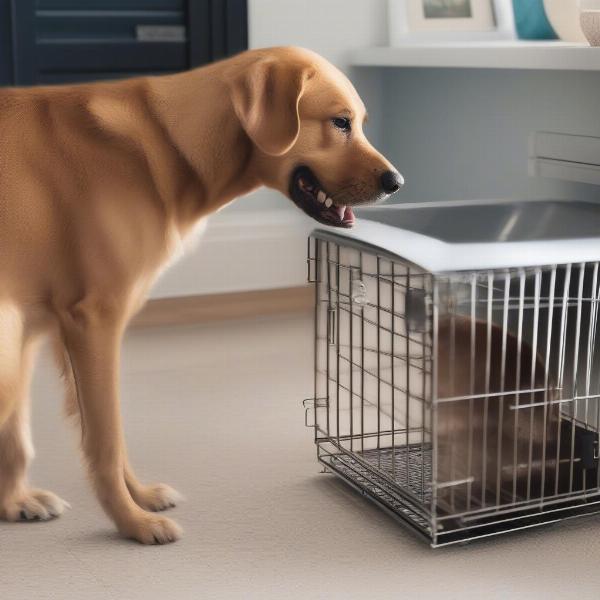Crate training, often misunderstood, is a valuable tool for raising a well-adjusted dog. It provides a safe, secure den for your furry friend and aids in housetraining, prevents destructive behavior, and offers a comfortable retreat during stressful situations. This guide will delve into the benefits of crate training, address common concerns, and provide a step-by-step approach to make the process successful for both you and your dog.
Why Crate Train Your Dog?
Crate training offers numerous advantages for dogs of all ages and breeds. A crate can be a safe haven, a place where your dog feels secure and can relax. This is particularly important for puppies who are still adjusting to their new environment. It also helps with housetraining as dogs instinctively avoid soiling their den. Furthermore, a crate can prevent destructive chewing and other unwanted behaviors when you’re unable to supervise your dog. It’s a useful tool for travel, making car rides and vet visits less stressful. Finally, a crate offers a comfortable and familiar space for your dog during potentially overwhelming situations like thunderstorms or fireworks.
Choosing the Right Crate
Selecting the right crate is crucial for your dog’s comfort and the success of your training efforts. The crate should be large enough for your dog to stand up, turn around, and lie down comfortably. For puppies, choose a crate that accommodates their adult size but includes a divider to restrict the space initially, preventing accidents. There are various types of crates available, including wire crates, plastic crates, and soft crate dog. Consider your dog’s breed, size, and personality when making your choice. A wire crate offers excellent ventilation, while a plastic crate provides more privacy. Soft crates are portable and ideal for travel.
Step-by-Step Crate Training Guide
Introducing your dog to the crate should be a gradual and positive experience. Start by making the crate a comfortable and inviting space. Place a soft crate dog beds or crate dog bed inside along with your dog’s favorite toys. Encourage your dog to explore the crate on their own by tossing treats inside. Never force your dog into the crate. Feed your dog meals near or inside the crate to create a positive association. Once your dog is comfortable entering the crate, begin closing the door for short periods, gradually increasing the duration.
 Dog being lured into a crate with treats
Dog being lured into a crate with treats
Addressing Common Crate Training Challenges
Some dogs may whine or bark when initially crated. It’s important to avoid releasing your dog while they are exhibiting these behaviors, as this reinforces the unwanted behavior. Instead, wait until they are quiet before opening the door. If your dog continues to struggle, consult a professional dog trainer for guidance. Remember, patience and consistency are key to successful crate training.
What if my dog has separation anxiety?
If your dog exhibits signs of severe anxiety when crated, it’s crucial to address the underlying separation anxiety first. This may involve consulting a veterinarian or a certified behaviorist. Crate training should not be used to manage separation anxiety and could worsen the condition if not handled properly.
Crate Training and Housetraining
Crate training can be a valuable tool for housetraining. Because dogs naturally avoid soiling their den, the crate encourages them to hold their bladder and bowels until they are taken outside. Establish a regular potty break schedule, taking your dog out immediately after they are released from the crate.
Crate Training an Adult Dog
While crate training is often associated with puppies, adult dogs can also benefit from it. The process may take a bit longer with an adult dog, but the same principles apply. Patience, positive reinforcement, and a gradual introduction to the crate are essential for success.
Conclusion
Crate training, when done correctly, is a beneficial and humane practice that can enhance your dog’s well-being and strengthen your bond. By providing a safe, secure, and comfortable space, you can help your dog thrive and feel more confident in their environment. Remember to choose the right crate, introduce it gradually, and be patient and consistent throughout the process.
FAQ
- How long can I leave my dog in a crate? This depends on your dog’s age and individual needs, but generally, adult dogs shouldn’t be crated for more than 6-8 hours at a time.
- What if my dog has an accident in the crate? Accidents can happen, especially during the initial stages of training. Clean the crate thoroughly and avoid scolding your dog.
- Is it cruel to crate train a dog? No, crate training is not inherently cruel. When done correctly, it provides a safe and comfortable den for your dog.
- Can I use the crate as punishment? Never use the crate as punishment. It should be a positive and safe space for your dog.
- What type of dog crate dog bed should I use? Choose a comfortable and washable bed that fits the crate size.
- My dog cries when I close the crate door, what should I do? Try leaving the room and returning when they are quiet. Gradually increase the time you are away.
- Can I crate train a small car crate dog? Yes, crate training is especially beneficial for car travel.
ILM Dog is a leading online resource dedicated to providing expert advice and information on all aspects of dog care. From breed selection to health, training, and nutrition, we offer valuable resources to help dog owners worldwide. Whether you’re a seasoned dog owner or just starting your journey, ILM Dog is here to support you. Contact us at [email protected] or +44 20-3965-8624 for personalized guidance.